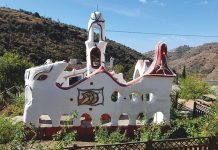Semana Santa (or Holy Week) is the Spanish name for Easter. It dates back to the 16th century when the Church decided to present the story of the Passion of Christ in a way that the layperson could understand. It was decided that the best way to do this would be a series of processions through the streets, depicting scenes from the story of the fall and rise again of Jesus Christ.
Though the style and mood of Semana Santa in Spain varies from city to city, the basic components remain the same.
Each day there is a number of processions, one from each brotherhood in the city, made up of floats which are carried from their church to the cathedral and back again. Most brotherhoods carry two floats, one with Christ and one with his mourning mother, Mary the Virgin.
Each procession is different and each one has its own particular followers, either due to the location of the church or the exact nature of the procession (the presence of or type of music, the time of day, etc).
The floats are heavy, especially so in Andalusia, which is the most extravagant region for Semana Santa. Strong men carry the floats, but with the procession lasting many hours, even they will feel the pain. The suffering experienced is likened to that experienced by Christ and the men (known as costaleros) consider it a great honor to carry the float, despite (and indeed, because of) the pain involved.
In Andalusia Semana starts on the Sunday before Easter and lasts until Easter Sunday itself, while in Castilla-Leon events run from the Friday before, making ten days of events. In Toledo, Semana Santa celebrations are even longer, starting on the Thursday two weeks before Semana Santa itself.
During the period of Easter in Spain, torrijas are eaten. These are thick slices of bread, soaked in milk and beaten egg, fried in olive oil and served with sugar or honey.
Another Easter food is un pestiño. This is a plain and simple little fritter. A flour mixture is fried in olive oil and then sprinkled with honey or sugar. Sesame is often added to the flour mixture.
Viernes de Dolores March 22
Sábado de Pasión March 23
Domingo de Ramos March 24
Lunes Santo March 25
Martes Santo March 26
Miércoles Santo March 27
Jueves Santo March 28
Viernes Santo March 29




















